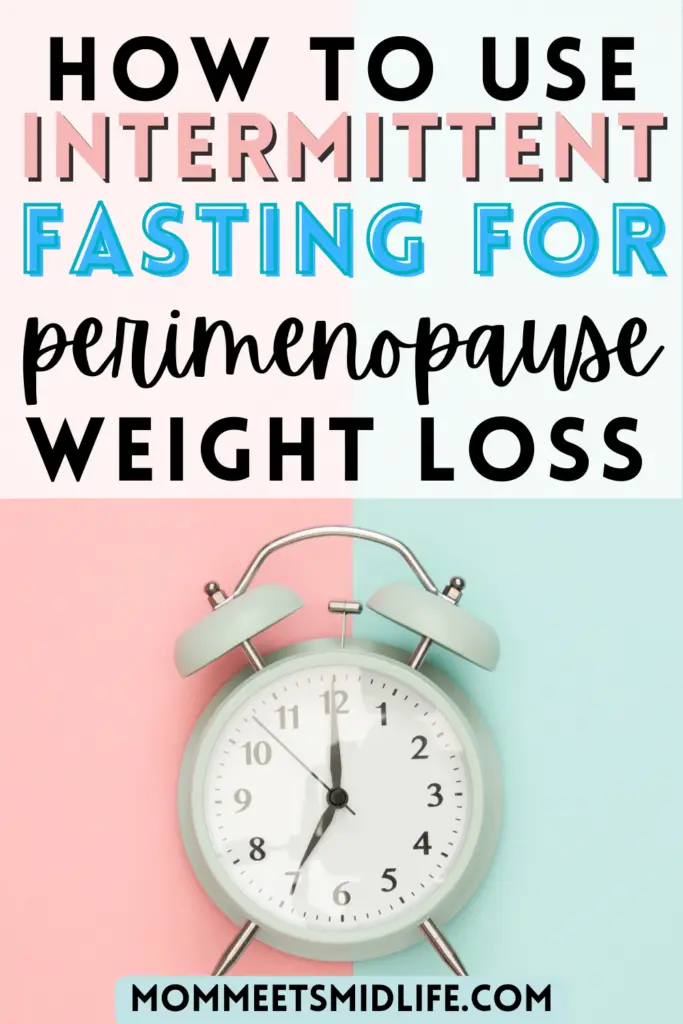Last Updated on April 14, 2023 by Erin
Are you tired of trying to figure out how to get back to your pre-kid weight? At this stage in the game, it’s not impossible, but it’s going to require some lifestyle changes. This post explains how to successfully use intermittent fasting for perimenopause weight loss.

You’re over 35 years old. You’ve finished having the babies. And you’ve tried really hard to lose the last few pounds of your stubborn baby weight.
Maybe you’ve tried a few strict diet changes, like cutting out sugar and dairy. Perhaps you started running and joining fitness boot camps.
And nothing works! The extra pounds are still there. Or maybe you’ve somehow gained even more weight. How dang frustrating!
Welcome to perimenopause, my friends. But don’t fret!
In this post, I am going to share what FINALLY worked for me and some programs that are backed by science. No snake oil or hopes and prayers, here!
**This post contains affiliate links. This means if you click and buy, I may receive a small commission (at zero cost to you). Please see my full disclosure policy for details.**
There are a lot of helpful tips here, so be sure to pin the post so you can find it later!
What Is Perimenopause?
If you haven’t heard this term before, you’re definitely not alone. The first time I heard about it was last year on Tik Tok (of all places!).
Perimenopause is basically the time leading up to menopause when your body starts to transition out of its reproductive years. It’s like the pregame show before the main event.
Your hormones start to go haywire, causing all sorts of fun symptoms like hot flashes, mood swings, and irregular periods.
Think you’re too young? Perimenopause can start as early as age 35.
I knew I was entering perimenopause when my very regular period started going off-script. Some months it’s almost a week early. In other months it’s almost a week late and I start to panic.
After ruling other issues out with my doctor, I accepted the truth and buckled up for the wild ride.
Why Is Losing Weight So Hard During Perimenopause?
Our hormones are all over the place during this time, which can affect our metabolism and make it harder to burn calories.
Also- as we age, our muscle mass tends to decrease, which means we burn fewer calories at rest. That means even if we’re doing the same amount of exercise as we did in our younger years, we may not be burning as many calories overall. How rude!
And lastly, let’s just be real – life is stressful. We’re juggling work, family, and all sorts of other responsibilities, which can lead to emotional eating and other unhealthy habits.
It’s not impossible to lose weight during perimenopause – it just takes a bit more effort and patience.
Does Intermittent Fasting Help with Perimenopause?
So, a few summers ago, my family spent some time at a distant relative’s lake house. One of the first things I noticed when we arrived was this woman was full of energy and incredibly in shape for her age.
I had to know her secrets. Spill, lady!
She told me she has found huge success with intermittent fasting, strength training, and daily walks.
I immediately started doing some research and forged a plan.
Four months into intermittent fasting I lost the last of my baby weight, which was 12 pounds. That felt monumental after 3 cesarean sections in 5 years.
In previous years I had paid for several postpartum workout and meal programs and saw zero success. All it took was eating breakfast later in the day and consuming all my daily calories in an 8-hour window.
Seriously.
And that was without exercise!
Trust me- intermittent fasting for perimenopause weight loss is a pretty easy and effective way to take control of your health. Just be sure to check with your doctor first.
How Does Intermittent Fasting Work?
Intermittent fasting is a pattern of eating where you alternate between periods of eating and fasting.
So instead of having three square meals a day, you might skip breakfast and not eat until lunchtime.
Or you might eat all three meals within a shorter time frame, like 8 hours.
The idea is that by restricting the time you spend eating, your body will start burning fat for fuel instead of glucose. It’s like giving your digestive system a break and forcing it to use up those love handles for energy.
Plus, some people find that it helps them manage their appetite and cravings. That has definitely been true for me!
What Are the Types of Intermittent Fasting?
There are several different types of intermittent fasting, including fasting for an entire day or two at a time.
Those types are not recommended for perimenopausal women. A time-restricted eating schedule is likely your best bet.
Time-restricted feeding involves limiting your eating window to a specific number of hours each day, typically 8-10 hours. For example, you might only eat between noon and 8 pm, and fast for the remaining 16 hours. This method may be easier for perimenopausal women to follow than other fasting methods that involve full day fasts or severely restricted calorie intake.
I would highly recommend building up to 16 hours of fasting. Much of that time period is going to be after dinner and while you’re sleeping (no more late-night munchies!) but you could still get woozy if you try to make it that long right out of the gate.
So perhaps start with 12 hours and work up to 16.
Example of Intermittent Fasting Schedule
Here’s what I do.
I fast from 6pm to 10 am.
When I wake up, I drink water, and then it’s coffee until my “brunch” at 10. Some hardcore fasters will disagree, but I use up to 25 calories of non-dairy creamer in my coffee. I just cannot and will not drink my coffee black.
In the afternoon, I typically have several snacks to make sure I’m getting enough calories. Intermittent fasting is not really a calorie-restricting diet. It’s just getting all your calories into a certain timeframe.
When dinner is done, I’m done eating for the day. I always make sure I have a very balanced meal so I’m not still hungry when I go to bed around 9.
Drinking plenty of water definitely helps. (Just not before bed, because nobody wants to be up all night peeing. We’re having enough difficulty with the random night sweats, ok?)
Why Is Intermittent Fasting Good for Perimenopausal Women?
When you eat, your body releases insulin to help regulate your blood sugar levels. But when you’re fasting, insulin levels drop and your body has to find a new source of energy to keep you going.
That’s where hormones like glucagon and growth hormone come in. They help your body break down stored glucose and fat into usable energy.
During a fast, your metabolism also shifts into high gear. Your body starts burning through your glycogen stores (which are like little energy packets in your muscles and liver) within the first 12-24 hours of a fast.
After that, it switches to burning fat for fuel instead. This can lead to increased fat loss over time, especially if you’re also exercising regularly and eating a balanced diet when you do eat.
Fasting can also affect other hormones in your body, like human growth hormone (HGH). HGH is responsible for things like muscle growth, bone density, and even anti-aging effects. Studies have shown that fasting can increase HGH levels, which may help preserve lean muscle mass during weight loss and improve overall body composition.
This is all great news for perimenopausal women because at this point in our lives, our metabolism slows down and we are more prone to blood sugar imbalances. We need all the help we can get, and intermittent fasting for perimenopause weight loss is the easiest help you can get!
Keep in mind- perimenopausal women should always talk to their healthcare provider before starting any new diet or exercise program. Intermittent fasting isn’t going to be the magical solution for everyone.
Additional Benefits of Intermittent Fasting in Midlife
Reduce Inflammation
Chronic inflammation can contribute to weight gain and a whole host of other health issues. Intermittent fasting has been shown to reduce inflammation in the body, which can support your overall health.
Reduce Cravings
Perimenopausal women may experience more intense cravings due to hormonal fluctuations or stress. Intermittent fasting can help control hunger and reduce the number of meals and snacks eaten throughout the day, which can help prevent overeating and promote healthy eating habits.
Hormones like ghrelin and leptin are responsible for controlling hunger and satiety. Intermittent fasting can help regulate these hormones, reducing the frequency and intensity of cravings.
No more late-night gummy bear binges!! No? Just me? Cool.
Autophagy
Auto-what?
Autophagy is like the Marie Kondo of your cells. Just like how she helps you declutter and organize your home, autophagy helps your cells get rid of any junk they don’t need and tidy up their space.
It helps get rid of your old cells so new ones can take their place. This process can slow down the aging process and prevent disease.
Pretty big deal, am I right?
How to Succeed with Intermittent Fasting for Perimenopause Weight Loss
Start slow: Intermittent fasting can be tough at first, so don’t try to jump right into a strict fasting schedule. Start by skipping one meal per day, or gradually increase the fasting window over time.
Listen to your body: Pay attention to how your body feels during the fasting period. If you feel dizzy, lightheaded, or overly hungry, it’s okay to break the fast early.
Stay hydrated: Drink plenty of water and other non-caloric beverages during the fasting period to stay hydrated and help curb hunger. If you’re worried about giving up coffee, keep drinking it with a minimal amount of creamer. And don’t forget to alternate cups of joe with cups of H2O.
Focus on nutrient-dense foods: During the eating window, focus on eating healthy, nutrient-dense foods that will provide your body with the energy it needs. Avoid filling up with empty calories and processed foods.
Be patient: Weight loss and other benefits of intermittent fasting may take time to become noticeable, so be patient and stick with it.
Get support: Join a community or find a friend to fast with you. Having support can make the process more enjoyable and help you stay on track.
What Is the Best Way to Lose Weight During Perimenopause?
Once my weight loss started to plateau, I started introducing exercise. I was in a good fasting routine and was ready to take it to the next level.
The best way to lose weight during perimenopause is to combine movement with your new fasting lifestyle.
I’m not a HUGE fan of exercise so I started with a daily walk. I felt so much better and I started losing a few more pounds.
The next step was adding in strength training. Adding weights to your exercise routine can help build bone density and muscle mass.
it’s important to choose a weight that challenges you without being too heavy. You should be able to perform 8-12 repetitions of each exercise with good form before feeling fatigued.
And be sure to hit each major muscle group throughout the week. You won’t get too bulky, I promise.
You will probably want to do your low-intensity activities (think walking or yoga) during your fasted state and save your strength training or more intense workouts after you’ve eaten.
Looking for some free workout plans? Here are several you can check out:
- Fitness Blender – This website offers a wide variety of free workout videos, including strength training, cardio, yoga, and Pilates. Search for free workouts.
- PopSugar Fitness – PopSugar Fitness offers a wide variety of workout videos that can be accessed for free on its website or YouTube channel. They also offer live workouts on Instagram.
- Yoga with Adriene – Adriene offers a wide range of yoga videos for free on her YouTube channel, including videos for beginners and advanced practitioners.
- Blogilates – Cassey Ho’s Blogilates offers free Pilates and strength training videos on her YouTube channel.
- HASfit – HASfit offers a wide variety of free workout videos, including HIIT, strength training, and yoga.
- Darebee – This website offers a wide variety of free workouts that can be done at home, including bodyweight workouts, yoga, and Pilates.
If you’re serious about using intermittent fasting for perimenopause weight loss, you’ll absolutely need to consider adding in exercise/movement at some point in the process.
Final Thoughts
Intermittent fasting is not a one-size-fits-all approach, and what works for one person may not work for another. Listen to your body, be patient, and above all, be kind to yourself!
Personally, I have days where I just need to break my fast earlier. I feel off and I know some protein will help. This is typically right before my period when my premenstrual dysphoric disorder rears its ugly head.
Because I know that my overall health has improved so significantly, I don’t stress about going off-script a few days each month. Life happens. Obsessing over an eating schedule is not healthy.
Get a rhythm going and before you know it, it’s a habit.
Also, please don’t stress about the number on the scale. The real measure of your health is how you feel.
If you are looking for a way to track your progress, check out My Fitness Pal. In addition to progress tracking tools, they have an extensive database of 500 recipes and 50 workout routines.
I know for me personally, I like to visualize progress and hard work. Plus, there are plenty of times I don’t have the energy to think about my meals. Having healthy and easy recipes at your fingertips is a lifesaver and will keep you from making unhealthy choices in a pinch.
I only recommend products and resources I actually find to be helpful. Promise.
If you have any more questions regarding intermittent fasting for perimenopause weight loss, please leave them in the comments below and I’ll be happy to answer them!
Here are a few more posts you might be interested in before you go:
Self-Care for Midlife Women
Early Midlife Crisis (Why It’s Normal and What to Do)
Simple Skincare Routine in Your 40s (Botox Free)
Mood Tracker Ideas for Midlife Women
Best of luck on your midlife and perimenopause journey!
Sincerely,
Erin



Pingback: Managing Energy as a Busy Mom with School-Aged Kids - Mom Meets Midlife